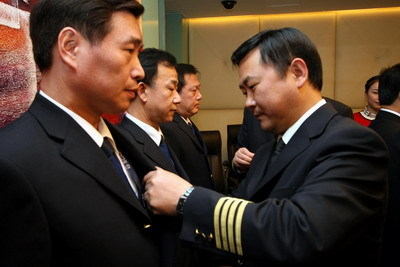Hands needed urgently to propel the wings
Updated: 2008-01-03 07:26
Pilots were never in such demand in China, or in such short supply, if you may say so.
Sichuan Airlines hired 12 pilots from Taiwan last month. It was the second batch from the island province.
|
|
The same airline recruited eight pilots on three- to six-year contracts two year ago, becoming the first mainland carrier to employ Taiwan pilots.
Taiwan's Zhang Luzhen made history by landing an Airbus 321 at Beijing's Capital International Airport in December 2005. He had flown from Chengdu, capital of Sichuan Province.
Taiwan pilots are flying to and from Nanjing, Xi'an, Shanghai, Guangzhou and Shenzhen, too.
All this has been made possible by the mainland's fast growing civil aviation sector.
The air transport industry has been growing at an annual rate of 16 percent, according to the General Administration of Civil Aviation of China (CAAC). In 2006, the authorities estimated that the country would need 9,100 more pilots by 2010 to fly the new Boeing and Airbus planes being added to Chinese carriers' fleets at the rate of 100-150 a year.
That precisely is where the problem is because pilots can't be trained to keep pace with the demand. The gap between the demand and supply of pilots is likely to be 2,000 by 2010.
China can now produce 1,400 new pilots a year, including the 400-odd that come out of China Civil Aviation Flight College (whose alumni include 90 percent of the country's 11,000 pilots and many senior CAAC officials such as its head Yang Yuanyuan.
The rest were trained by airlines, which prepare students in theories in aviation colleges and universities at home, and send them abroad for flight lessons.
Dearth of pilots is a problem common to all mainland airlines, from the big three - Air China, China Eastern and China Southern - to the private ones. To overcome the problem, they have sought the help of domestic aviation colleges and universities, as well as foreign flight schools.
Professor Li Xiaojin of the Tianjin-based Civil Aviation University of China says at least four carriers - Shenzhen Airlines, Shanghai Airlines, China Southern and China Eastern - have adopted this strategy to get enough pilots for their fleets.
Air China, the national flag carrier, even set up an aviation university in Beijing's Shunyi district last month to train pilots. It has signed a letter of intent with the University of North Dakota's Aerospace Foundation, a leading US pilot training institute, for the four-year degree course.
Unfortunately, even that is not likely to solve the problem instantly. "The problem is that no matter how many pilots are trained every year, each new plane that is delivered needs five pilots and five first officers to ensure a smooth operation," CAAC's Flight Standard Department official Yang Hu said over the phone yesterday.
Fresh flight school graduates can be employed just as first officers for the first six to seven years after, and only after that can they become full-fledged pilots, Yang said.
But the airlines buying the new Airbuses and Boeings cannot wait that long.
Airbus alone is expected to deliver 372 planes to Chinese airlines from December 2007 to 2012. Boeing is expected to supply another 335 aircraft.
In an interview with China Daily last month, Air China's former chairman Li Jiaxiang said he had to request the two companies to provide 25 foreign pilots to fly the airline's newly purchased planes. That request was met.
Immediately, other Chinese airlines did the same because they were facing the same problem, he said.
Overseas recruitment
Another practise adopted by the airlines is to recruit directly from abroad. Shenzhen Airlines is the largest single employer of overseas pilots. It has recruited 40 pilots from Brazil. If those hired from Europe and Russia earlier are added, the percentage of overseas pilots on the mainland would be 10.
So far, 491 overseas pilots have got their licenses from CAAC to work for Chinese airlines. The actual number of those working is less, though, because some of them have quit their jobs on the mainland, a CAAC official said.
The CAAC has issued regulations simplifying the process for airlines to hire overseas pilots to have enough experienced pilots for the time being at least.
But, some experts say, the shortage of pilots won't last long. The country could have more than enough pilots as early as in five years, Li Xiaojin said.
|
|
|
||
|
||
|
|
|
|
